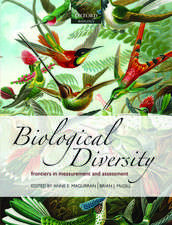Himalayan Biodiversity in the Changing World
Editat de Pavel Kindlmannen Limba Engleză Paperback – 23 aug 2016
| Toate formatele și edițiile | Preț | Express |
|---|---|---|
| Paperback (1) | 941.82 lei 6-8 săpt. | |
| SPRINGER NETHERLANDS – 23 aug 2016 | 941.82 lei 6-8 săpt. | |
| Hardback (1) | 945.79 lei 6-8 săpt. | |
| SPRINGER NETHERLANDS – 16 sep 2011 | 945.79 lei 6-8 săpt. |
Preț: 941.82 lei
Preț vechi: 1148.56 lei
-18% Nou
Puncte Express: 1413
Preț estimativ în valută:
180.24€ • 186.20$ • 150.01£
180.24€ • 186.20$ • 150.01£
Carte tipărită la comandă
Livrare economică 26 martie-09 aprilie
Preluare comenzi: 021 569.72.76
Specificații
ISBN-13: 9789401778879
ISBN-10: 9401778876
Pagini: 226
Ilustrații: X, 226 p.
Dimensiuni: 155 x 235 mm
Greutate: 0.34 kg
Ediția:Softcover reprint of the original 1st ed. 2012
Editura: SPRINGER NETHERLANDS
Colecția Springer
Locul publicării:Dordrecht, Netherlands
ISBN-10: 9401778876
Pagini: 226
Ilustrații: X, 226 p.
Dimensiuni: 155 x 235 mm
Greutate: 0.34 kg
Ediția:Softcover reprint of the original 1st ed. 2012
Editura: SPRINGER NETHERLANDS
Colecția Springer
Locul publicării:Dordrecht, Netherlands
Cuprins
Preface.- An overview of the biodiversity in Nepal.- Conservation of biodiversity: an outline of the challenge.- Orchid diversity in the Chitwan district.- Distribution and diversity of storks in the adjoining areas of Chitwan National Park, Nepal.- Interactions between the Himalayan tahr, livestock and snow leopards in the Sagarmatha National Park.- Numbers, distribution and facts limiting the abundance of tigers (Panthera tigris) in the Bardia National Park extension area.- Impact of livestock grazing on the vegetation and wild ungulates in the Barandabhar Corridor Forest, Nepal.- Challenges to wildlife conservation posed by hunting in non-protected areas north of the Bardia National Park.- Delineating wildlife corridor in an agriculture mosaic: effects of landscape and conservation patterns.- Where to go next?.- Species index.- Subject index.
Recenzii
From the reviews:
“The book is well referenced throughout and exposes the reader to literature beyond what is presented in the empirical case studies. … Also useful are numerous good-quality photographs and maps, which allow the reader to put the case studies into appropriate context. … This book, therefore, appeals to multiple audiences … it is a useful starter and a suitable text for undergraduate or postgraduate students. … make a lasting contribution to conservation of Himalayan biodiversity in the face of rapid change.” (Shonil A. Bhagwat, Mountain Research and Development, Vol. 32 (3), August, 2012)
“The book is well referenced throughout and exposes the reader to literature beyond what is presented in the empirical case studies. … Also useful are numerous good-quality photographs and maps, which allow the reader to put the case studies into appropriate context. … This book, therefore, appeals to multiple audiences … it is a useful starter and a suitable text for undergraduate or postgraduate students. … make a lasting contribution to conservation of Himalayan biodiversity in the face of rapid change.” (Shonil A. Bhagwat, Mountain Research and Development, Vol. 32 (3), August, 2012)
Notă biografică
Pavel Kindlmann is professor of ecology at the Charles University in Prague, Czech Republic and performs research on various aspects of biodiversity as the Head of the Biodiversity Research Centre, in the CzechGlobe - Global Change Research Centre, Academy of Sciences, in České Budějovice, Czech Republic. His main interests include population and metapopulation dynamics and life history strategies with a special emphasis on insect herbivores, their predators, and on the orchid family. He authored or edited several books on population systems, orchids and conservation biology and published about 100 scientific papers in prominent journals.
Textul de pe ultima copertă
This book presents some results on selected taxa in the Himalayan region (mainly Nepal), pinpoints the threats to their survival and suggests ways how to avoid their extinction. Most chapters are based on graduate research projects – relatively long-term field studies. The data presented here can be a good source of updated information on the subject and will prove to be a very useful reference in future studies of Himalayan biodiversity. They also tend to pinpoint the existing gaps in our knowledge of this region. All the chapters are based on recent trends of biodiversity and conservation vision, so the book can be a potential alternative to the existing relatively older books with outdated vision and information. Its main goal, however, is to disseminate the information about biodiversity conservation problems in the Himalayan region among the people in the developed world. The book can serve as a good source of reference or even as a textbook for both graduate and undergraduate students in conservation biology and mountain ecology.
Caracteristici
The only recent book on biodiversity in the Himalayas Presents unique data on various animal and plant groups from the Himalayan region Important for conservation of the Himalayan species















